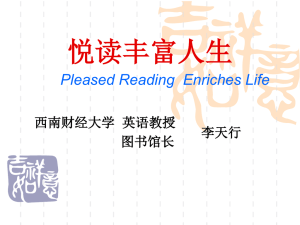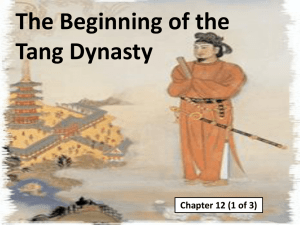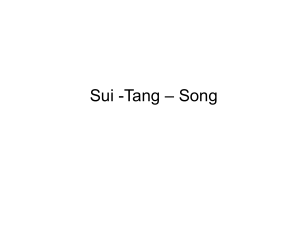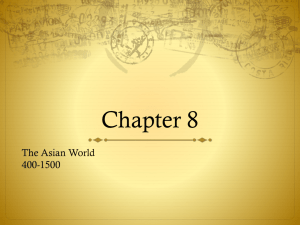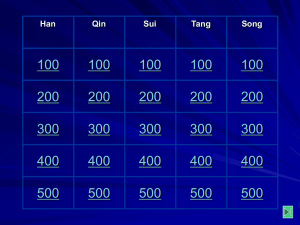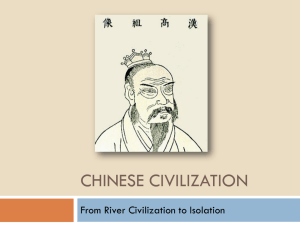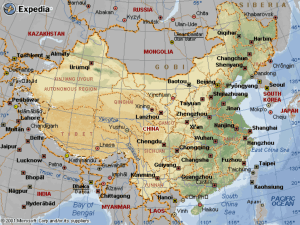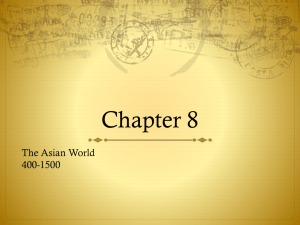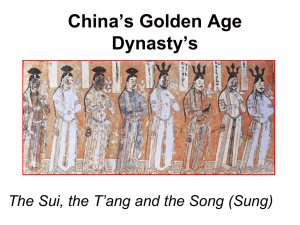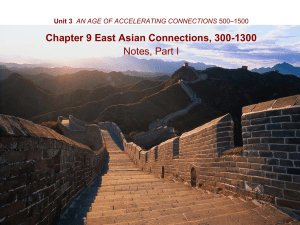12.1 PowerPoint
advertisement
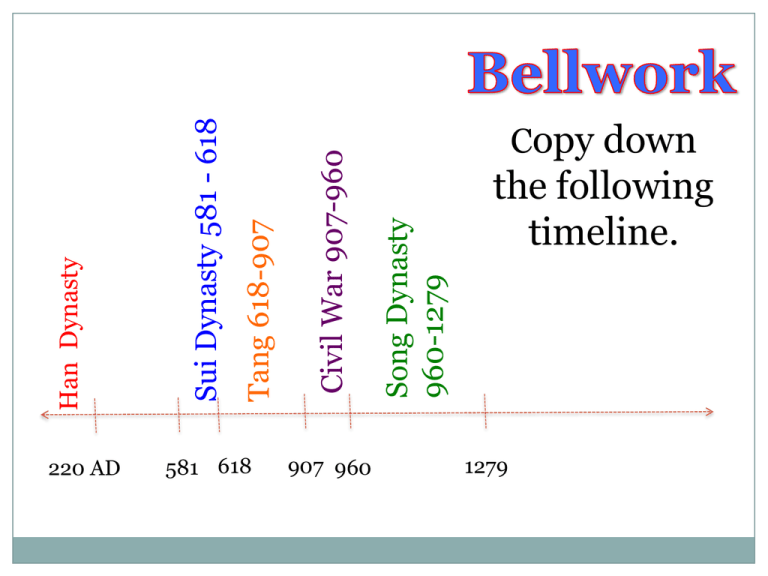
220 AD 581 618 907 960 Song Dynasty 960-1279 Civil War 907-960 Tang 618-907 Sui Dynasty 581 - 618 Han Dynasty Copy down the following timeline. 1279 China Reunites SECTION 12.1 Today’s Objective 7.20 Describe the reunification of China under the Tang Dynasty and reasons for the cultural diffusion of Buddhism. You can explain how the Tang dynasty unified China under their leadership. Rebuilding China’s Empire In 220 AD, the Han Dynasty ended in China. For 300 years, warlords fought with each other over territory. In 581 AD, China reunited when a general named Wendi declared himself emperor. He founded a new dynasty called the Sui. After Wendi died, his son Yangi took over. He tried to take the Korean Peninsula, but lost in battle. Rebuilding China’s Empire – Grand Canal His greatest effort was to build the Grand Canal. It linked the Yangtze River and Yellow River It became an important route for shipping products between northern and southern China. Rebuilding China’s Empire Yangdi may have rebuilt China, but he used the Chinese people to do it. Farmers were forced to work building the Great Wall and Grand Canal. They had to pay higher taxes to pay for these projects. The farmers revolted, the army took control and killed Yangdi, the Sui Dynasty ended. The Tang Dynasty (618–907) In 618, one of Yangdi’s generals took over China and made himself emperor – creating the Tang. Reforms during Tang Dynasty Restored civil service exam system – hired based on how ell they did on the exam rather than on their family connections Increased the strength of its military and added more officials to the government Expanded territory under its control, took control of the Silk Road, invaded Tibet, forced the Koreans to pay tribute to be left alone, and invaded northern Vietnam. Tang Dynasty Mid-700s, the Turks began attacking the Tang armies, pushing them out of Central Asia and taking control of the Silk Road away from the Tang. This leads to the fall of the dynasty. Song Dynasty (960-1279) For 50 years after the fall of the Tang Dynasty, military rulers ruled China. Then in 960, one of the generals declared himself emperor creating the Song dynasty. A period of prosperity and cultural achievement for China. Problems were there as well. Not a big enough army Tibet broke away Nomads took control of northern China Today’s Objective 7.25 Engage effectively in a collaborative discussion describing the development of the imperial state and the scholar-official class (Neo-Confucianism) You can explain reasons for the cultural diffusion of Buddhism. Buddhism Spreads to China Traders and missionaries brought Buddhism to China around 150. The Han Dynasty was dying out and then the country was in a Civil War for 300 years. People were looking for a way to escape their suffering and many Chinese turned to Buddhism as the answer. Chinese Buddhism Tang dynasty allowed Buddhism to be practiced. They even supported the building of Buddhist temples and monasteries. Buddhist temples provided services, schools, rooms and food for travelers. Some people feared Buddhists’ growing power. In 845, Tang officials ordered many Buddhist temples and monasteries destroyed. New Confucian Ideas Confucianism had been a popular idea under the Han Dynasty, but had been lost during the years of the warlords. It becomes popular again in a new form under the Tang Dynasty called Neo-Confucianism. Neo-Confucianism taught that life in this world was just as important as the afterlife. Followers were expected to take part and help others. It added some Buddhist and Daoist beliefs. People thought if you followed Confucius’ teachings, they could find peace of mind and live in harmony with nature. The Song Dynasty supported it as well. Scholar-Officials Civil Service Exam was used in both Tang and Song dynasties to hire officials. You had to be hired for what you can do instead of your personal contacts. Because the civil service exam concept came from Confucian’s ideas, the examination tested job seekers on their knowledge of Confucian writings. While the tests were fair, only men could take the test and only wealthy men could afford to pay people to help them study for the test. Scholar-officials The examination system created a new wealthy class in China made up of scholar-officials. Students preparing for their exams. They didn’t do physical work.


